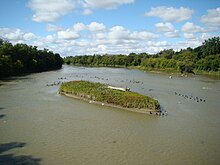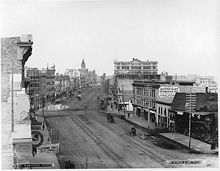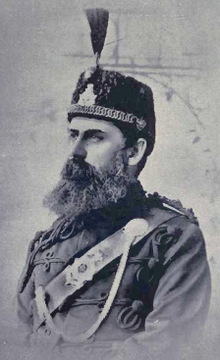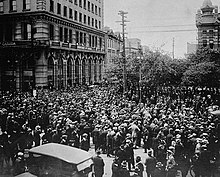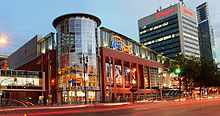Winnipeg
| Winnipeg | ||
|---|---|---|
 Winnipeg city center |
||
 coat of arms |
 flag |
|
|
Motto : Unum Cum Virtute Multorum ("One with the strength of many") |
||
| Location in Manitoba | ||
|
|
||
| State : |
|
|
| Province : | Manitoba | |
| Region: | Winnipeg Capital Region | |
| Coordinates : | 49 ° 54 ′ N , 97 ° 9 ′ W | |
| Height : | 238 m | |
| Area : | 464.01 km² | |
|
Inhabitants : - Metropolitan Area : |
663,617 (status: 2011) 730,018 (status: 2011) |
|
| Population density : | 1,430.2 inhabitants / km² | |
| Time zone : | Central Time ( UTC − 6 ) | |
| Postal code : | R2C - R3Y | |
| Mayor : | Brian Bowman | |
| Website : | www.winnipeg.ca | |
Winnipeg [ ˈwɪnɪpɛg ] is the capital of the Canadian province of Manitoba and at the same time its largest city by far. In 2011 it had over 660,000 inhabitants, the metropolitan region around 730,000. This makes Winnipeg the seventh largest city in Canada. The name is derived from the Winnipegsee located 55 kilometers north ; In the local Cree language, “win” means muddy and “nipee” means water.
Known as the Gateway to the West , Winnipeg is a rail and transportation hub with a diversified economy . The city is multicultural and home to several sports clubs. Winnipeg was the first Canadian to host the Pan American Games in 1967 . The city is known for numerous annual festivals, including the Winnipeg Folk Festival .
geography
Winnipeg is located near the geographic center of North America at the confluence of the Red River and Assiniboine Rivers , a floodplain protected from flooding by the Red River Floodway , a bypass activated during flooding.
Cityscape and structure
Winnipeg is located in the Red River valley, which has few hills. The same goes for the urban area. It has four rivers, the Red River, the Assiniboine, the La Salle, and the Seine River .
230 neighborhoods divide the provincial capital. The core area and starting point of urban growth is or was Downtown Winnipeg in the area of Portage Avenue and Main Street. From here the arterial roads radiate in all directions. The area of the city center is approximately 2.5 square kilometers. Urban growth largely followed the two main rivers.
The urbanized area covers an area of 25 × 20 kilometers, but has significant undeveloped areas. The two most important parks are Assiniboine Park and Kildonan Park .
The main centers of the entertainment and cultural industries are in the Exchange District, The Forks, Osborne Village, Little Italy, Sargent and Ellice Avenues (West End) and Old St. Boniface, the French quarter. As The Forks , the place is called where the Assiniboine River discharges into the Red River and was on 18 May 1974 National Historic Site of Canada explained. The confluence and the surrounding cultural landscape bear witness to six thousand years of human activity as a meeting point, trading center and settlement.
climate
The city has a continental climate , has hot summers and is one of the coldest cities in the world in winter. During five months of the year the average temperatures are below freezing point.
| Winnipeg | ||||||||||||||||||||||||||||||||||||||||||||||||
|---|---|---|---|---|---|---|---|---|---|---|---|---|---|---|---|---|---|---|---|---|---|---|---|---|---|---|---|---|---|---|---|---|---|---|---|---|---|---|---|---|---|---|---|---|---|---|---|---|
| Climate diagram | ||||||||||||||||||||||||||||||||||||||||||||||||
| ||||||||||||||||||||||||||||||||||||||||||||||||
|
Average monthly temperatures and rainfall for Winnipeg
Source:
|
||||||||||||||||||||||||||||||||||||||||||||||||||||||||||||||||||||||||||||||||||||||||||||||||||||||||||||||||||||||||||||||||||||||||||||||||||||||
history
Early history
Paleo Indians
Manitoba was settled by Indian groups after the end of the last Ice Age, but the meltwater from the huge ice block that covered most of the province formed between 10,000 and 6,000 BC. The so-called Agassizsee , which also covered the area of today's Winnipeg.
The western Plano culture around 8000 to 4500 BC. The buffalo jumps were already used for hunting , in which herds of bison were driven over cliffs in order to be able to kill them easily. Important sites of this culture are west of Winnipeg in the valley of the Swan River . In the more recent phase of this culture, the Sister Hills Complex , people followed the retreating southern shore of Lake Agassiz northwards. Nomadism was replaced by a cycle of seasonal migrations that depended on hunting and vegetation cycles.
Between 6000 and 4000 BC During a warm phase, the forests expanded northward, up to 300 kilometers beyond today's tree line. The group known as the Northern Plano Culture probably came around 8500 BC. From Saskatchewan and extended their migrations eastwards. The Eastern Plano extended from Lake Agassiz to Lake Superior . Its main location is on Caribou Lake northeast of Winnipeg. It was a culture that was more adapted to forests. Stone rings, which were used to fix tents, are among the oldest relics.
Archaic phase until around the birth of Christ
Within the Archaic phase , a younger and an older phase are distinguished, with a transition around 3500 BC. New hunting techniques emerged, such as the spear thrower (Atlatl), at the same time today's bison replaced the bison antiquus with its longer horns. For the first time grave goods can be identified. Finds from Logan Creek and Mummy Cave Complexes indicate immigration from the west and south.
The Oxbow Complex dominated the southwest, but artifacts were also found on Lake Winnipeg. The groups probably consisted of 40 to 60 individuals. One of the main sites of this complex is Kuypers Site on the banks of the Assiniboine River . Extensions of the McKean Complex from Wyoming , which was based on a hot and dry climate, were also found at the Kuypers site . Apparently vegetable food was of less importance to them, but reptiles were also hunted.
The Pelican Lake Complex shows clear differences and indicates the immigration of new ethnic groups. The dead were buried in pits , preference was given to Knife River Flint , and grave goods acquired through long-distance trading.
Woodland from 200 BC Until 1750
Among the finds at Wanipigow Lake a good 200 kilometers northeast of Winnipeg were pottery shards that are among the oldest in the province. This layer, known as laurel , dates back to around 2000 years; it was based less on grasslands than on forests and fisheries. During this time, wild rice was planted here for the first time.
During the Woodland period pottery was created, mounds were erected, bows and arrows replaced the atlatl and corn , pumpkin and beans changed the way of life so much that it is assumed that people were becoming increasingly sedentary. Hunting retained its importance in the fringes of the culture, while it almost disappeared in the core areas. Here, too, a distinction is made between an early and a late phase, the time limit of which can be seen around 800. The culture of the Mississippi , especially Cahokia , and Ohio had an impact far into Manitoba. The Arden Camp Site is the northernmost mound of the province. It is located west of Winnipeg. On Stott Mound at Brandon were found flints from the Knife River in Dakota. The site has been in use since 800 AD at the latest.
The later plain woodlands phase is characterized by horticulture and wild rice. The Lockport Site on the east bank of the Red River shows the cultivation of corn and storage. Clay pots indicate contacts as far as Dakota and Minnesota ( Psinomani culture ). The position was only given up around 1500 because it was too cold. Possibly between 800 and 1400 the west migration of the Ojibway brought with it a style of clay processing known as the Blackduck phase .
First Europeans, fur trading companies
In contrast to the Cree , who offered themselves to the European trading companies as fur hunters, the late Taltheilei people and their descendants, the Dene, hardly changed their way of life. Not only did the two groups live very differently, they also often fought.
In 1738 the first trading post, Fort Rouge , was established in the area of present-day Winnipeg , but was later abandoned.
In the battle between the Hudson's Bay Company (HBC) and the North West Company for supremacy in the fur trade, trading posts were again established in the region. Fort Garry was founded in 1809 by the North West Company under the name Fort Gibraltar at the confluence of the Assiniboine and Red Rivers known as The Forks . In 1816 it was destroyed in the Pemmican War , which lasted from 1815 to 1820. When the conflict ended with the merger of the two rival companies in 1821, Fort Garry in what is now downtown Winnipeg, the center of the fur trade in the surrounding areas of the Red River Colony .
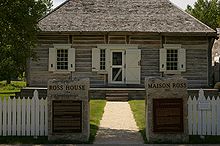
In 1826 Fort Garry was destroyed by a flood and rebuilt in 1836 under the name Upper Fort Garry , to distinguish it from Lower Fort Garry at the confluence of the Red River in the Winnipeg Sea. Métis settled around the fort , who hunted buffalo and sold pemmican made from them to the Hudson's Bay Company. In addition, they operated on a small scale on farms according to the seigneurial system on the river banks ( river lot ).
In 1855 the first post office building, today's Ross House Museum , was built by William and Jemima Ross. The Council of Assiniboia had made William Ross, the son of Alexander Ross, sheriff and postmaster in 1851 . He performed the latter function in his own house, which he had built for £ 252. In the absence of stamps , he signed a total of 2912 letters with "Red River, BNA" (British North America). Only at the destinations like Pembina were the letters stamped. Ross earned £ 5 a year, but he died in 1856. Two years later, his widow married William Coldwell, co-editor of the first Red Rivers newspaper, the Nor Wester . William's brother James took over the management of the family on his return and became the spokesman for the English-speaking population of the colony, just as Louis Riel was the spokesman for the French-speaking people.
Transition from HBC to Canada
In 1869 the Canadian Dominion acquired Ruperts Land from HBC , which also included the Red River Colony. When surveyors were sent to the Red River to stake out areas for new settlers from Ontario in 1870, the Métis feared for their land rights, rose up in the Red River Rebellion under Louis Riel and sought admission to the Canadian Dominion as a Provisional Government. The capital became Upper Fort Garry, as it had previously been the seat of the Assiniboia Council . Negotiations between the Provisional Government and the central government in Ottawa resulted in a fundamental agreement, the Manitoba Act , which largely recognized the claims of the Métis. However, their leader Riel was denied an amnesty for the rebellion he led.

On November 8, 1873, the city of Winnipeg was established around Upper Fort Garry under the Manitoba Act , but most of the Métis followed the dwindling herds of buffalo west, leaving few of the original residents in the new city until the 1880s . Manitoba, which was initially very small, derided as the “stamp province”, was expanded to its present size by 1912.
John Norquay , Prime Minister from 1878 to 1887, was a member of the English-speaking Métis from the Red River Colony. He tried to resolve language, origin and confessional disputes. Meanwhile, the province's population increased sixfold from 1871 to 1891 from 25,228 to 152,506. The immigrants were mostly British and they came into conflict with the Catholic and French-speaking Métis.
In order to gain farmland for them, the Indians with the Numbered Treaties were forced to give up their land and move to reservations . The first of these eleven contracts concerned the Winnipeg region and was signed on August 3, 1871. Affected were the Chippewa and Swampy Cree Tribes of Indians , i.e. the tribes of the Brokenhead Ojibway Nation with today 1707 state-recognized members, the Fort Alexander (6951) (today Sagkeeng First Nation), the Long Plain (over 3500), Peguis (8701) , Roseau River Anishinabe (2255), Sandy Bay (5636) and Swan Lake (1218), a total of over 30,000 members of today's First Nations .
Railway connections
Francis Evans Cornish became the first Mayor in January 1874, followed by William Nassau Kennedy. Alexander Logan, multiple Mayor in the years 1882–84, campaigned for the rail link to run through Winnipeg. He also offered tax exemptions and land donations.
The Canadian Pacific Railway was created against the increasing economic connection to the USA . In favor of this rail connection, Norquay initially hindered any private railway construction. In contrast, the Manitoba Liberal Party represented the interests of settlers and entrepreneurs who were interested in exporting to the south. When Norquay promoted the expansion of the Red River Valley Railroad from Winnipeg towards the US border in 1887 , the Canadian Prime Minister opposed Norquay. Wheat export was facilitated by the rail link to St. Paul , Minnesota . With the completion of the CPR, the inner-Canadian west-east connection, in 1886, Winnipeg became an important loading center on the first transcontinental railroad. It became Canada's fourth largest city, dominated by the Anglican-British majority, trying to wipe out French heritage. In 1910/11, construction of a rail link from Winnipeg to Churchill began on the Hudson Bay Railway .
industrialization
The proportion of the rural population soon decreased in favor of the industrial workers. But their wages fell behind those of other employees and so began the Winnipeg general strike on May 15, 1919 , which lasted until June 25. During the violent intervention of the federal police on June 21, "Bloody Saturday", thirty people were injured and one killed. Mayor Charles Frederick Gray replaced some of the police in order to suppress the strike. Mayor Thomas Sharpe, who violently attacked strikers of the Winnipeg Electric Railway Company, had acquired the nickname "Gatling Gun Sharpe" in 1906, after the Gatling Gun . Later mayors, such as Ralph Humphreys Webb, who held office from 1925-28 and 1930-34, demanded during the strike that "the whole gang should be sunk in the Red River". During another strike in 1931, he demanded the deportation of the agitators.
Immigration to the city was further increased by the global economic crisis and several years of drought. This tendency was reinforced by the Second World War with its rapidly increasing demand for raw materials, agricultural products and, above all, industrial goods, especially in the Winnipeg area. If Day , the simulation of a German raid on the city, was held on February 19, 1942 .
To protect Winnipeg from the Red River floods , which were particularly severe in 1950, Prime Minister Dufferin Roblin had the Red River Floodway built, still known today as Duff's Ditch . It was supposed to protect the capital from flooding. Mayor Garnet Coulter (1943–54) set up a fund to compensate for the damage, the Manitoba Flood Relief Fund .
Unity Act, bilingualism, independent energy policy
In 1969, the NDP under Edward Schreyer won the election. He enforced Winnipeg's current constitution in 1971, the Unity Act . The current districts of St. James-Assiniboia, St. Boniface, Transcona, St. Vital, West Kildonan, East Kildonan, Tuxedo, Old Kildonan, North Kildonan, Fort Garry and Charleswood were combined with the original parish of Winnipeg. In order to avoid urban sprawl , the city administration restricted building to a clearly defined area.
In 1979 the Supreme Court reinstated the Manitoba Act of 1870, restoring the province's official bilingualism to nearly ninety years.
Since 1882, by resolution of the Justice Committee of the Privy Council, the province has been almost sovereign in the areas of natural resources, property, civil rights, education, welfare and health. Manitoba has a local business elite in Winnipeg with their own policies. In 2004 Manitoba's first wind farm was built 150 kilometers southwest of Winnipeg on a hill, the Pembina Escarpment , on an area of 9,000 hectares ; it delivers 99 megawatts from 63 wind turbines and thus supplies up to 35,000 households with electricity. In September 2007, Prime Minister Gary Doer prevented the deforestation of valuable forest for a power line that was instead being built west of Lake Winnipeg.
Susan Thompson became the first woman to be mayor in 1992 and she ruled until 1998. In 2004, Sam Katz, Winnipeg elected its first Jewish mayor. He was re-elected on October 25, 2006 with more than 60 percent of the vote. In 2008 he assumed the position of Secretary of Urban Aboriginal Affairs . Together with David Chartrand, President of the Manitoba Métis Federation (MMF), he initiated a program that aims to increase awareness of belonging among the Métis and the members of the First Nations and Inuit, who make up over 10 percent of the population, through more participation and better professional training (' It's My Community Too ').
population
Winnipeg had 663,617 residents in 2011, about 55 percent of Manitoba's total population. Between 2006 and 2011, the population of Winnipeg increased by 30,166 people. Winnipeg's annual growth rate has been 0.5 percent since 1971. Most of the growth is generated by migratory movements from nearby sparsely populated areas, Indian reservations , and by extending the city limits to neighboring cities.
Minorities
Once Canada's fourth largest city, Winnipeg's population growth has lagged since the 1970s, with the result that it was only 10th in 2004. Winnipeg is home to 10 percent indigenous people , 6 percent Filipinos , 2 percent South Asians, Blacks and Chinese, 1 percent Southeast Asians and Latin Americans and 2 percent other minorities.
Religions and denominations
According to the 2001 census, around 445,000 of the 610,445 inhabitants were Christians. 214,235 of these were Protestants, 199,025 Catholics, 10,280 Orthodox and a further 21,725 belonged to other denominations. Winnipeg is home to the world's largest settlement of Mennonites or Russian mennonites .
In addition there were 12,555 Jews, the largest Jewish diaspora in Canada, 5,335 Buddhists and 5,285 Sikh , 4,690 Muslims, and 3,605 Hindus. 130,740 were non-denominational. Of the non-Christian parts of the population, well over 90 percent of the total provincial population lived in the capital.
Winnipeg is the seat of the Archdiocese of Winnipeg .
Economy and Infrastructure
economy
Winnipeg is an important business location in the province for the immediately neighboring communities and suburbs. Many companies from various sectors of the economy have settled in Winnipeg. The city's largest industries are financial services, manufacturing, retail, and tourism companies.
As of July 2010, approximately 409,500 people were directly employed in Winnipeg and the surrounding suburbs. Major employers in the city include: Multiple Municipal Agencies and the University of Manitoba, Healthcare Institutions and Hospitals, and Manitoba Hydro . 54,000 people are employed in the city's facilities. The larger private companies include a .: Shaw Cablesystems , Manitoba Telecom Services , Ipsos , Palliser Furniture, Canada Life, Motor Coach Industries , New Flyer Industries , Boeing Canada , Bristol Aerospace , Nygård International and Royal Canadian Mint .
education
There are seven so-called school divisions in Winnipeg. These are the Winnipeg , St. James-Assiniboia , Pembina Trails and the Seven Oaks School Divisions , then the Scolaire Franco-Manitobaine Division , the River East Transcona and the Louis Riel School Divisions . There are also private schools that are not assigned to the school divisions .
The University of Manitoba , UM, is the province's largest university and the only research university. She has been part of the Canadian Association of Research Universities , the U15 Group of Canadian Research Universities , since 2011 . It was founded in 1877. In 2009 it had around 26,000 students and employed 8,000 people. The Université de Saint-Boniface is organisationally part of the UM, it mainly accepts French-speaking students.
The University of Winnipeg was founded a few years earlier. Manitoba College was established in 1871 and Wesley College in 1888 . They were united in 1938 and the new institute was now called United College . Until 2007 it was only responsible for undergraduates , so it was only authorized to lead students to a first university degree. She founded her own Aboriginal Student Services Center for members of the First Nations and the Métis . It is not only intended to serve the indigenous people at the university, but also to strengthen contacts with the often remote communities.
The Canadian Mennonite University was founded in 1999 and is a private university of Mennonites with approximately 1600 students. Colleges were also merged here, namely the Canadian Mennonite Bible College from 1947, the Concord College , which was created in 1944 as Mennonite Brethren Bible College , and the Menno Simons College from 1988, whose namesake was Menno Simons (1496-1561).
The Red River College and the Booth College are independent colleges . Booth College is a Salvation Army facility that was established in 1982.
The city also houses one of Canada's most important archives , the Hudson's Bay Company Archives . It moved from London to Winnipeg between 1970 and 1974 and has been open to the public since 1995.
media
The first newspaper in Winnipeg and thus in the province was founded in 1872 under the name Manitoba Free Press . Under the current name of Winnipeg Free Press , it is the only paper from the founding phase between 1859 and 1890 that still exists today. The first edition was published by William Fisher Luxton and John A. Kenny on November 30, 1872. It was made in a cabin at 555 Main Street. The Prairie Farmer established itself as a weekly newspaper . After several moves, the newspaper moved to 300 Carlton St. in 1913, where it resided until 1991. Today 1355 Mountain Avenue is the headquarters. The Winnipeg Tribune began in 1890, but was closed in 1980. In the same year the Winnipeg Sun was founded. In addition to all the print media, the larger broadcasters such as CTV , CBC and Global TV operate several local broadcasting studios in the city. There are also several radio stations such as u. a. Hot 103.1FM in Winnipeg.
Public facilities
The Winnipeg Police Service is responsible for public safety with around 1,400 officers and 400 civilian employees. These have five police stations that are responsible for five districts. In addition, the Federal Police RCMP has an office in Winnipeg. The Winnipeg Fire Paramedic Service is responsible for fire-fighting and first aid medical care and maintains around 27 fire brigade bases with medical staff, as well as four other rescue stations .
Winnipeg has ten hospitals including the Health Sciences Center , Concordia Hospital , Deer Lodge Center , Grace Hospital , Misericordia Health Center , Riverview Health Center , Saint Boniface General Hospital , Seven Oaks General Hospital , Victoria General Hospital and The Children's Hospital of Winnipeg . These hospitals also typically serve people outside of Winnipeg whose smaller towns do not have a hospital. The National Microbiology Laboratory is the Canadian disease control center, which is one of only a handful of worldwide security centers that corresponds to the highest security level 4. The National Research Council operates the Institute for Biodiagnostics laboratory, which is located downtown.
Culture and sights
Downtown
There are several shopping centers in Winnipeg. The largest mall in Winnipeg with more than 200 shops, restaurants, cafes and bars is Polo Park . Other larger shopping centers include Cityplace, Garden City Shopping Center and Grant Park Shopping Center.
Parks
In Winnipeg there are several parks with sufficient green areas that invite you to relax and unwind. The largest park in the middle of downtown Winnipeg is Central Park . The park is located between Notre Dame Avenue and Elice Avenue, and Donald Street and Balmoral Street . There are several historical monuments and memorials in the park. Various events are held on the park grounds in summer. In the southern part of the city is Kings Park, which is on the western side of the Red River. It houses a Japanese garden, soccer and baseball fields. Another recreational park is located in Winnipeg Beach . This is located on Lake Winnipeg , in which you can also swim. The park is located around 55 kilometers north of Winnipeg.
theatre
Winnipeg has several major theaters and other entertainment venues. The Centennial Concert Hall , the Manitoba Theater Center (MTC) and the Pantages Playhouse are right downtown. The MTC is Canada's oldest English-speaking regional theater with over 250 events per year. The Pantages Playhouse Theater opened in 1913. Le Cercle Molière, located in St. Boniface, is the oldest theater company in Canada. The French-speaking theater, which was founded in 1925, moved to a new building in 2010. Other theaters include the Burton Cummings Theater and the Winnipeg Jewish Theater (WYD), which mainly host Jewish performances.
Art and museums
There are several museums in Winnipeg. The Manitoba Museum is the largest museum in the city and has several exhibits related to the history of the province and the city. The Winnipeg Art Gallery is Canada's oldest public gallery, which opened in 1912. Another museum is the Western Canada Aviation Museum , which is located at James Richardson International Airport. It has exhibits of civil and military aircraft, including Canada's first helicopter, avrocar, flight simulators, and a Black Brant missile built by Bristol Aerospace. A train museum is located at the Via Rail station and has several locomotives, including the Countess of Dufferin, the first steam locomotive in Western Canada. The Canadian Museum for Human Rights , designed by the American architect Antoine Predock , opened in Winnipeg in September 2014 . It is near downtown in an area where the Red River and Assiniboine Rivers flow together, known as The Forks . Construction of the museum began in the spring of 2009; completion was originally planned a year earlier.
Sports
Sports teams
- The Winnipeg Jets are an ice hockey team in the NHL . The franchise has been based in Winnipeg since 2011 and emerged from the Atlanta Thrashers after it was sold to a Canadian group of investors.
- From 1979 to 1996, the city of Winnipeg already had an NHL ice hockey team called the Winnipeg Jets . The Jets previously played in the WHA, which dissolved in 1979, for seven years . Except for the name, however, there is nothing in common with the current NHL franchise.
- The Manitoba Moose are an ice hockey team in the second rate AHL .
- The Winnipeg Blue Bombers are a football team in the CFL .
traffic
Winnipeg is the operational hub of VIA Rail Canada- operated transcontinental long-distance train The Canadian , which connects the city with Saskatoon , Edmonton , Jasper , Vancouver and Greater Sudbury - Toronto, as well as the rest of the North American rail network. In addition, Winnipeg is the starting point of the long-distance train The Hudson Bay , which travels about 1,700 kilometers to the north of Manitoba to Churchill . Long-distance buses connect Winnipeg with Sioux Falls in the USA, among others . The city is on the Trans-Canada Highway and is home to Winnipeg International Airport including CFB Winnipeg . Winnipeg Transit is responsible for local passenger transport , which operates around 80 lines and is also responsible for the suburbs.
Under Mayor George Sharpe (1955–56) streetcars, a type of tram, were abolished, which Sharpe considered a great asset for the progress of the city.
Town twinning
Winnipeg is twinned with the following eleven cities:
| city | country | since |
|---|---|---|
|
Beer Sheva |
|
1984 |
|
Cheng you |
|
1988 |
| Jinju |
|
1991 |
|
Kuopio |
|
1982 |
|
Lviv |
|
1973 |
|
Manila |
|
1979 |
|
Minneapolis |
|
1973 |
|
Reykjavík |
|
1971 |
|
San Nicolás de los Garza |
|
1999 |
|
Setagaya |
|
1970 |
|
Taichung |
|
1982 |
Personalities
See also
literature
- Winnipeg . In: La Grande Encyclopédie . 20 volumes, Larousse, Paris 1971–1976, pp. 14674–14675 (French).
- Esyllt W. Jones: Influenza 1918: Death, Disease and Struggle in Winnipeg. University of Toronto Press 2007.
- Esyllt W. Jones, Gerald Friesen: Prairie Metropolis. New Essays on Winnipeg Social History. University of Manitoba Press 2009.
Web links
Individual evidence
- ^ Winnipeg Census Metropolitan Area (CMA) with census subdivision (municipal) population breakdowns. Statistics of Canada. March 13, 2007.
- ↑ Geomorphology of the Red River, Natural Resources Canada ( Memento June 4, 2011 in the Internet Archive )
- ^ Statistics Canada.
- ^ The Forks National Historic Site of Canada. In: Canadian Register of Historic Places. Retrieved on August 4, 2020 .
- ↑ Canadian Climate Normals 1971–2000: Winnipeg Richardson International Airport.
- ↑ This and the following after: Paleo Period. Manitoba Archaeological Society 1998.
- ^ Oxbow Complex.
- ^ Boreal Forest Woodland Period, Wanipigow Site, EgKx-1.
- ^ Sheila Grover: Ross House, A Manitoba Historical Society Museum. First in: Manitoba History 2, 1981.
- ↑ Statistics Canada ( Memento of December 31, 2006 in the Internet Archive ).
- ↑ The figures from January 2010 come from the Department of Indian Affairs and Northern Development , but only include the state-recognized "Indians" according to the Indian Act .
- ↑ Thomas Sharpe . In: Dictionary of Canadian Biography . 24 volumes, 1966–2018. University of Toronto Press, Toronto ( English , French ).
- ^ Population and dwelling counts, for Canada and census subdivisions (municipalities), 2011 and 2006 censuses. Statistics Canada, accessed August 10, 2012 .
- ↑ Tables Aboriginal population and Visible minority population characteristics. Statistics Canada.
- ^ Statistics Canada.
- ↑ Trends Report. winnipeg.ca (PDF file; 418 kB)
- ^ Winnipeg Economic Base ( Memento of December 16, 2007 in the Internet Archive )
- ^ Students, Summary. University website.
- ↑ Our History. UM website
- ↑ The History of the University of Winnipeg ( September 1, 2009 memento in the Internet Archive )
- ↑ About CMU.
- ^ According to the presentation of the newspaper: History. Winnipeg Free Press - Partners in Progress.
- ^ The Winnipeg Tribune. University of Manitoba. Archives and Special Collections.
- ^ Health Agency of Canada. Retrieved August 1, 2011.
- ↑ Canadian Museum for Human Rights opens amidst controversy and protests National Post , September 19, 2014, accessed June 19, 2016
- ↑ Human rights museum construction hits milestone. CBC News , September 20, 2012, accessed February 14, 2013 . (English)
- ^ Winnipeg's last streetcar rolls into history. CBC, September 25, 1955.
- ^ Municipal manual - City of Winnipeg. (PDF) Retrieved December 29, 2018 .

